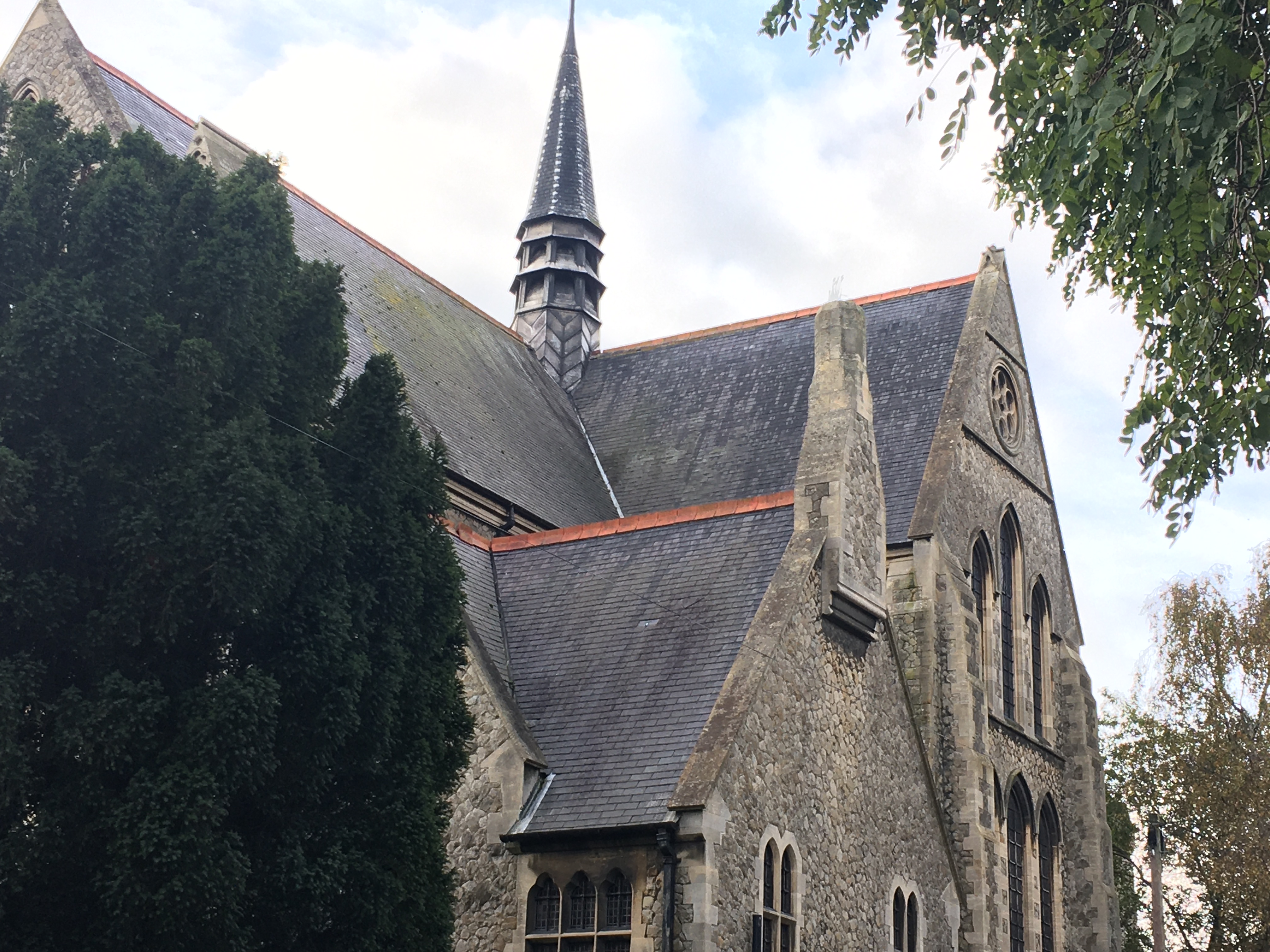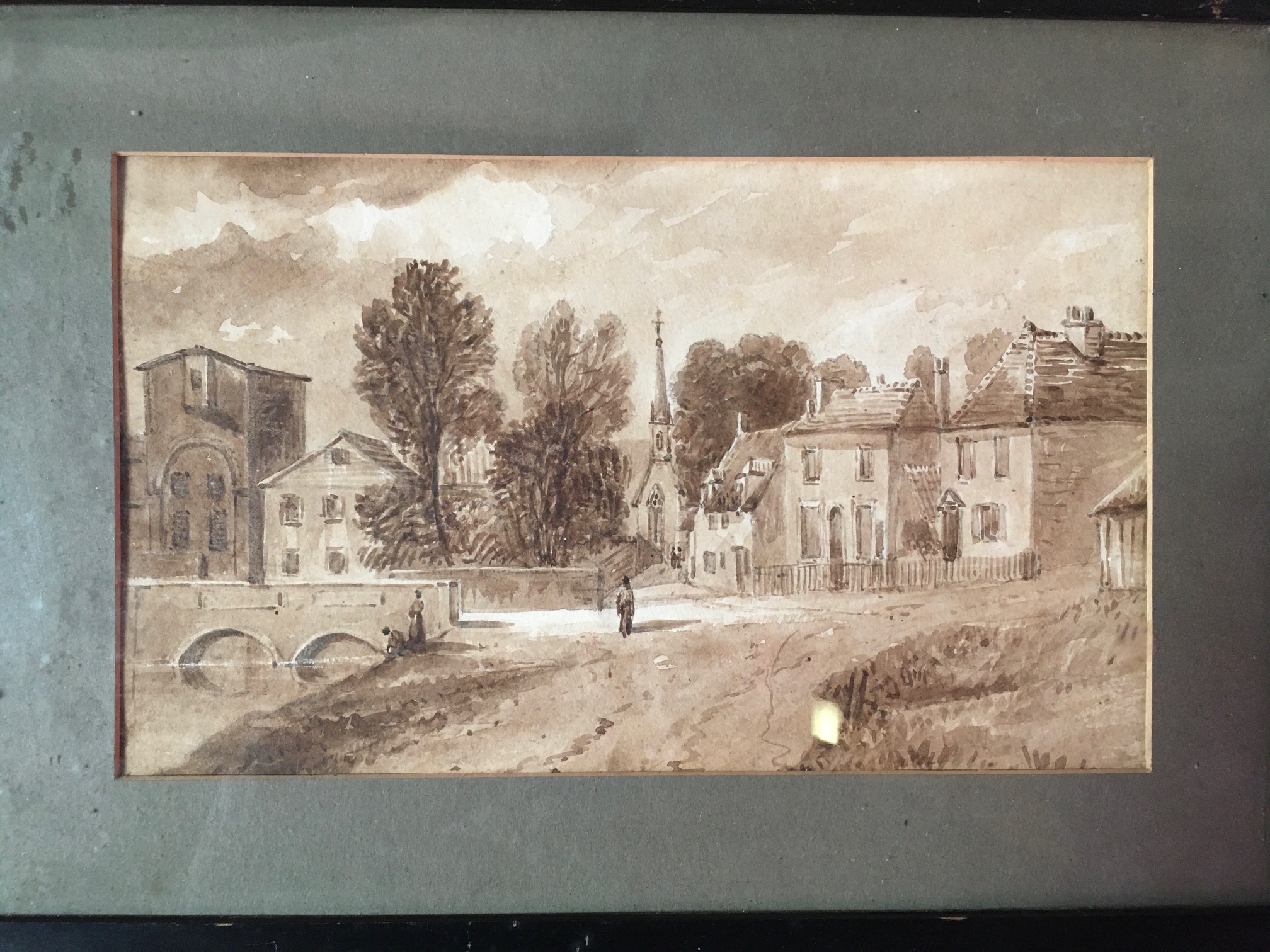
This charming watercolour shows the old Charlton Church on Charlton Green, from what is now Maison Dieu Road, with the River Dour and the paper mill.
A HISTORY OF THE PARISH CHURCH OF St PETER & St PAUL CHARLTON IN DOVER
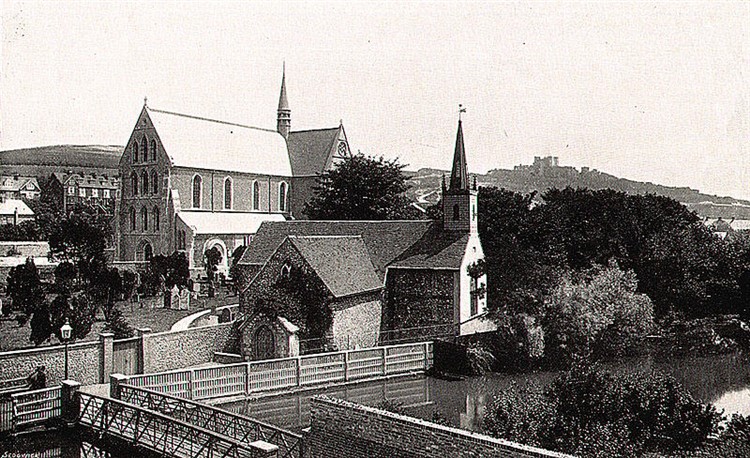
As church buildings go, Charlton is not very old, but Christian worship may have been held on or near this site for more than 1300 years. St Peter and St Paul is a splendid Victorian building which became the centre of a thriving Christian community and continues to seek to be deeply involved in the life of the neighbourhood.
And now a bit of history........
In the library at Lambeth Palace there is a fragment of ancient manuscript which mentions the dedication of the Chapel of St. Peter at Charlton by Walter, Lord Bishop of Rochester who was acting on behalf of his brother, Theobald who was Archbishop of Canterbury. Walter held the See of Rochester from 1147-1182 and a list of Charlton Rectors gives the year 1160 as the date when Odo, son of Richard Moryn, became the first Rector of the Parish.
Thus 1160 may well be the date of the consecration of the tiny chapel. However, the actual Manor of Charlton goes back to Saxon times, but was very small and the inhabitants very poor.
The original church stood not on the site of the present building, but nearer the River Dour. A stone set in the grass of the churchyard marks the site of the old High Altar.
A plan of 1895 shows that the old building cut across what is now Charlton Green and the old Fancy Box Factory site (now apartments).
ORIGINAL CHURCH
In 1827, it was decided that the time had come to enlarge the little church. This was made imperative, one imagines, by the growth in population at this period. From 15 at the time of the Doomsday Book, the population of Charlton had grown to 278 in 1801. By 1811, it had risen to 600 and by 1821 had reached nearly 800.
The church was enlarged by the novel expedient of cutting it in half and building a new section through the middle. This is clearly visible in pictures still in existence of the 1827 church.
There is also in existence a small oil painting of the inside of the church as it appeared soon after the enlargement. It brings out the lovely simplicity of the Georgian interior - the delicate wrought-iron communion rails, the traditional tablets of the Ten Commandments flanking the Holy Table and the uncluttered sanctuary.
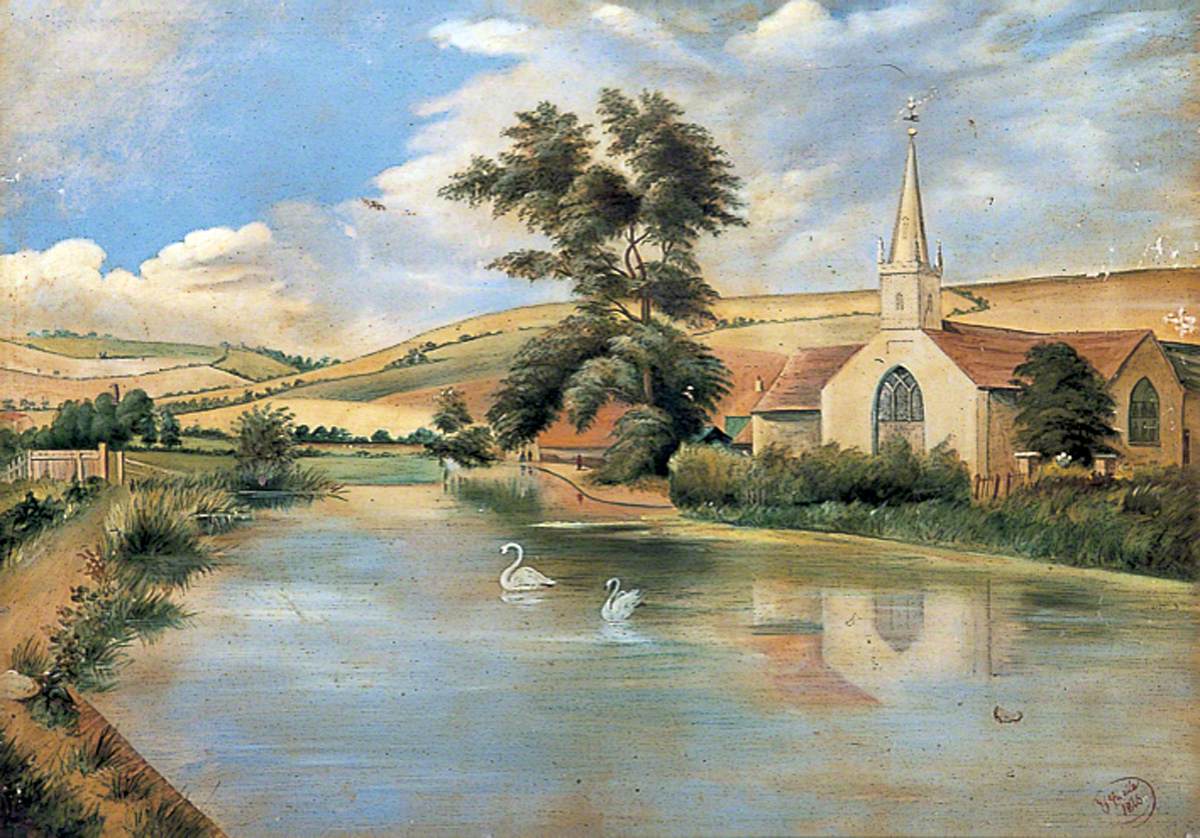
Old Charlton Church
By the 1870s, the village of Charlton was expanding rapidly. This was especially true of the area we know as Tower Hamlets where hundreds of houses were being built for the people from the dock area of Dover. In 1878, a daughter church (St. Bartholomew's) was built together with a vicarage, schools, a hall and a Working Men's Club.
The old village around Charlton Green was also growing in size and prosperity. The poor little church by the river was felt to be inadequate and so a grandiose scheme for a new church was prepared by the eminent architect James Brooks. Copy and paste this link into your browser to find out about this influential architect and how Charlton fits into his portfolio.
file:///Users/Camilla/Downloads/JAMES%20BROOOKS%20Charlton%E2%80%99s%20architectThe%20History%20of%20Architecture.pdf
Brooks also designed the vicarage in St Alphege Road, now called Felbrigg House.
The new church was built on the site of the old Charlton School and Master's House and was consecrated on St. Alphege Day, April 19th, 1893. The English Church Union met the cost of the chancel as a tribute to the heroism of the Rector, the Reverend Sidney Faithorn-Green, who spent twenty months in Lancaster Jail rather than recognise the authority of the Privy Council in church affairs.
BOTH CHARLTON CHURCHES
For two years, the two Charlton churches stood side-by-side, but in 1895 the old church, with all its charm and history, was pulled down and the rubble used partly to construct the new boundary wall, and partly for the footings of the great bell tower which was part of Brookes' scheme. Money seems to have run out, however, and Charlton Church is still without its tower. The square mound on which the tower was due to stand is still visible just outside the south porch.
The present building is noteworthy mainly for its spaciousness, its acoustics, and for the simple dignity of its pillars and arches. Although Brooks specialised in grand churches that used relatively cheap materials, one might have expected in a church of this period a magnificent reredos below the double row of windows at the East End such as we see in some of his other churches (see link below). However, a recently uncovered photograph, perhaps taken when the church was consecrated (note the Easter flowers), shows an elegantly simple Gothic-revival rood screen across the broad chancel.
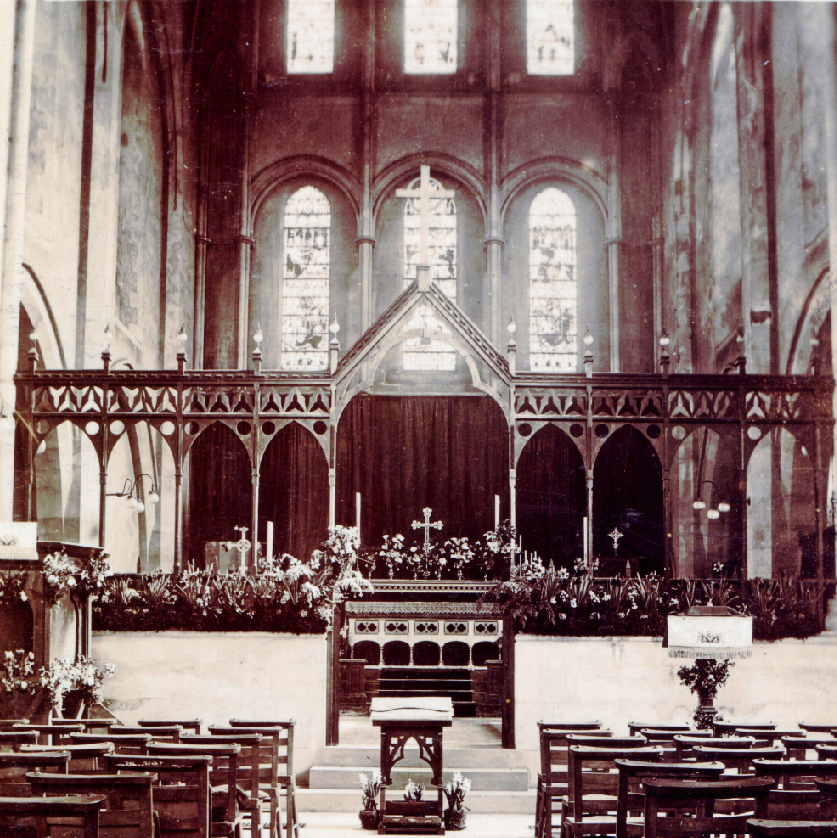
The beautiful marble top of the High Altar was donated by Brooks in memory of his wife. The marble paving in the sanctuary and chancel & the marble and alabaster communion rails are not original. The organ and choir stalls were transferred from the old church: the historic, prize-winning Bevington organ is still in use, but the choir stalls were replaced during the post-war reconstruction with some heavy oak stalls rescued from the bombed church of St. Barnabas. The site of that lost church is now occupied by the playing field of Barton Road school.
In September 1944 Charlton Church was badly damaged by shells fired from the German batteries on the French coast at Calais and it was at this time that St. Barnabas Church in Barton Road was also badly damaged. The only remaining evidence of the damage sustained to Charlton Church at that time is the south-western pillar of the nave arcade. Close inspection will show that this pillar no longer sits squarely on its base - thanks to a shell which landed in the churchyard and exploded beneath the foundations of the church.
After the war, extensive restoration work was necessary, including the partial rebuilding of the east and west walls and the re-roofing of the entire church.
In 1960, a Church Hall was added on a piece of land which had formed part of the Rectory Garden and which was sold by the Rector to the Church Council for a shilling. In 1975, the Crypt was turned into a meeting room and coffee bar - suffering from damp, it currently awaits restorative work.
At the same time, an attempt was made to remedy the somewhat makeshift arrangement of the sanctuary and east end by blocking up three of the eastern windows and installing large classical-style reredos behind the High Altar. Although this is out of keeping with the gothic architecture and also completely out of proportion with the rest of the building, it is a striking feature which adds to the uniqueness of the church. One day perhaps it will be possible to remove it and replace the blocked-up windows, thus recapturing something of the architect's original scheme for this church.
St. Bartholomew's continued as a separate parish until 1971 when it was merged once again with the ancient parish of Charlton. The vicarage and church of St Bartholomew were demolished, but many treasured possessions were brought to Charlton where they are now in regular use.
Charlton Church - the 'cathedral of the town' - boasts some beautiful stained glass windows above the reredos, six lights in both the north and south aisles, the sanctuary, the Lady Chapel, at the west end of the church together with the remarkable St. Bartholomew's Window in the south transept and at the west end of the church.
The organ pre-dates the current church, having been moved from the old church on Charlton Green. The smoked oak pulpit is dedicated to the memory of Fr. Sidney Faithorn-Green (Rector from 1889-1914) who was responsible for the building of both the church and rectory. Until recently Keble College, Oxford was responsible for appointing the parish priest and in the St. Bartholomew Chapel on the north side of the church there is an altar used by John Keble himself, one of the leaders of the Tractarian Movement in the Church of England. This movement eventually led to the adoption of many practices we accept today such as vestments and candles on the altar. Such things were forbidden by an Act of Parliament for a time in the late nineteenth century and it was for contravening this law that Fr Faithorn-Green was jailed.
This short history was compiled by Fr Bill Shergold during his time as Rector between 1969-78, was augmented by Dave Brewster and Fr Colin Johnson, and was edited by Camilla Otaki (Churchwarden September 2025).
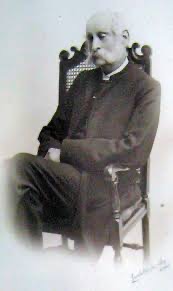
Fr Sidney Faithorn Green, and below, the old and new churches. Green oversaw the transition from the old to the new church, and was working to pay off the church's building costs for the rest of his time at Charlton.
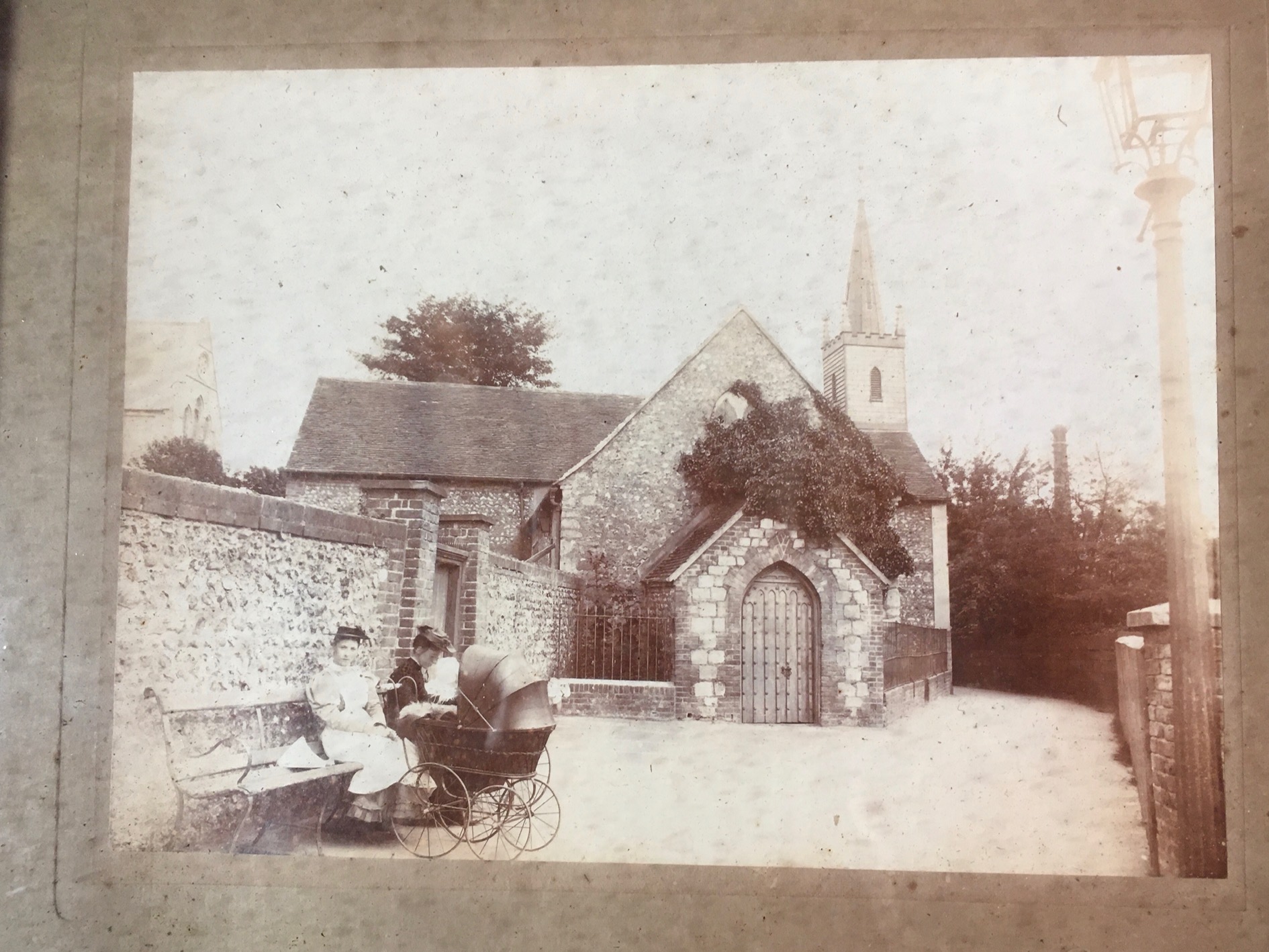
Charlton Church today.
